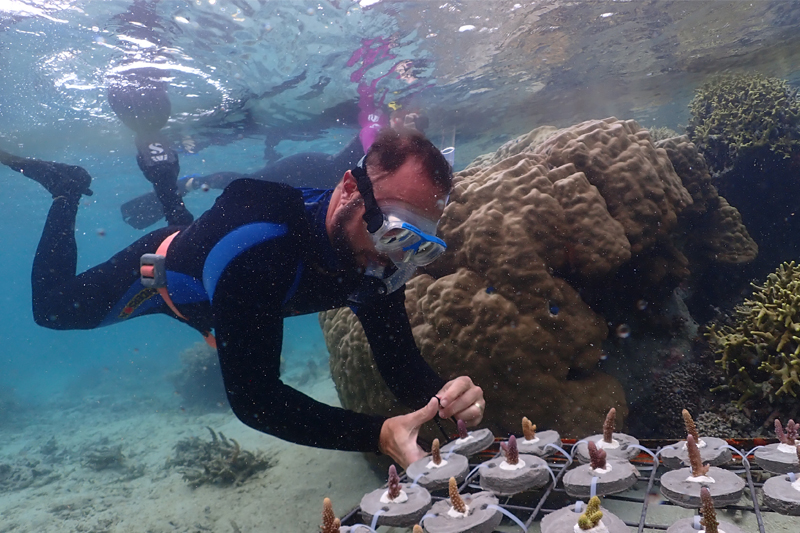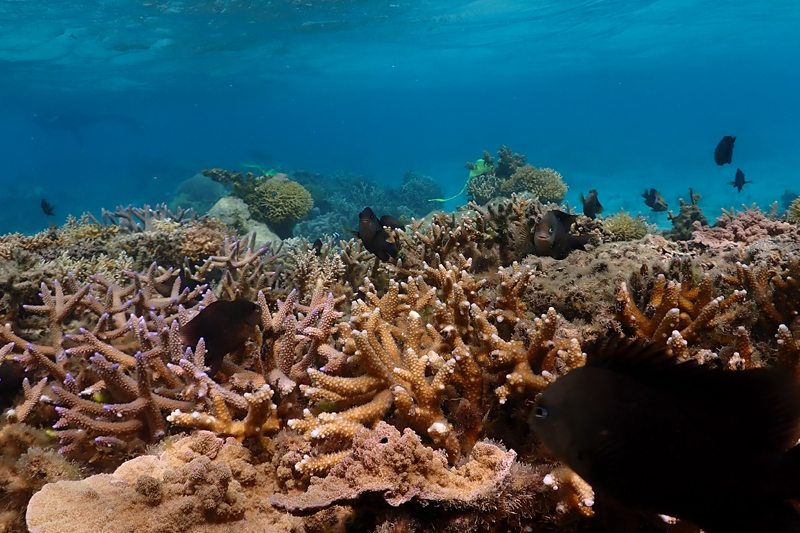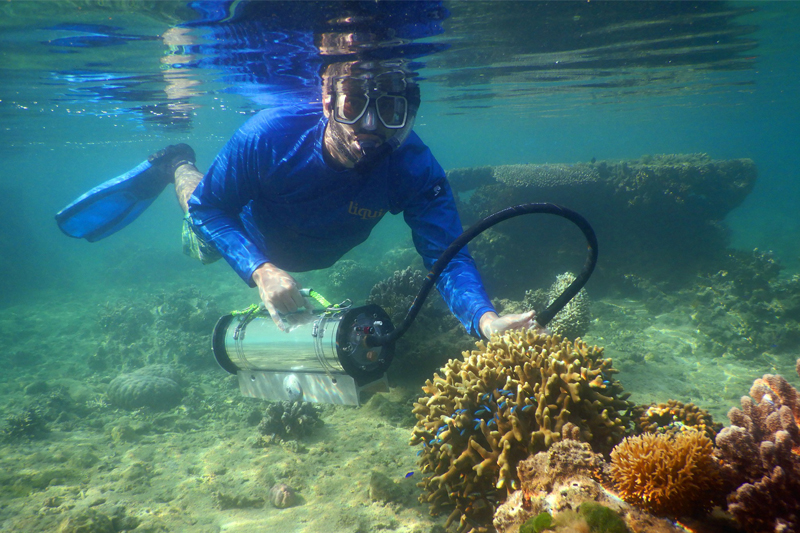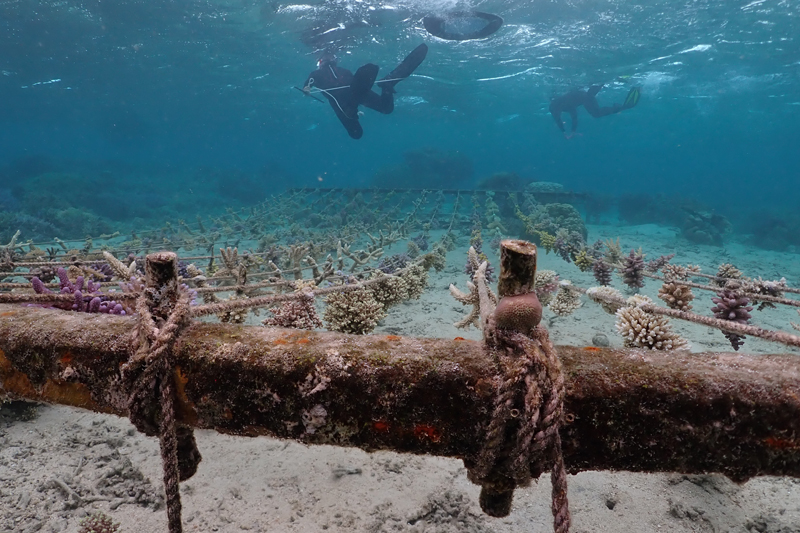


Finding heat-tolerant corals
Photos courtesy of Mark Warner and Liz Baker Hoadley December 06, 2023
Two studies look to improve reef resilience by determining how coral species respond to temperature fluctuations
As global warming causes temperatures to rise in oceans across the globe, it will be critical to discover novel ways to identify reef corals that are susceptible or tolerant to future heating for those reefs to survive and thrive into the future. Coral reefs provide many benefits for ecosystems — supporting 25% of all marine species and acting as hotbeds for biodiversity — as well as the communities in which they are located. The reefs protect coastlines from erosion and storms, provide jobs for local communities and provide recreation activities for locals and tourists.
Two new studies with an international group of researchers, including those from the University of Delaware, are looking to determine how different coral species respond to water temperature fluctuations by sampling coral species in Fiji, Guam and Florida. The goal is to determine which coral can be used in different environments to help with coral reef restoration projects and to improve the resiliency of reef systems through transplanting corals with high thermal tolerance.
The research is led at UD by Mark Warner, professor in the School of Marine Science and Policy in UD’s College of Earth, Ocean and Environment.
The first project is funded through a $615,000 grant from the National Oceanic and Atmospheric Administration’s (NOAA) Ruth Gates Innovation Grant and was given to Warner, Kenneth Hoadley, an assistant professor at University of Alabama based at the Dauphin Island Sea Lab and the lead on both projects, and Mote Marine Laboratory. This project will focus on the Florida Keys.
The second project is funded by a $1.5 million award from the Coral Research and Development Accelerator Platform (CORDAP), a large-scale initiative, with funds coming from the G20 and managed through King Abdullah University of Science and Technology in Saudi Arabia. This project involves Warner, Hoadley and their colleagues involved in reef restoration and research in Fiji and Guam — Victor Bonito of Reef Explorer Fiji and Bastian Bentlage and Laurie Raymundo at the University of Guam.
Both projects will begin in 2024 and are funded for three years.
Diverse test sites
Warner said having the projects focused on Fiji and Guam, as well as Florida, will allow researchers to look at two areas of the world where the corals have been damaged because of climate change.
“It’s a tricky time in Florida because the reefs have just been battered so badly,” said Warner, who pointed out that last summer water temperatures rose so drastically that the Florida Keys were suffering from massive bleaching. “Florida has been hammered by elevated seawater temperatures and hammered by disease. It already has low coral cover and less than 10% of that cover is the reef building corals.”

The test sites will allow the researchers to work in vastly different coral restoration environments that represent resource heavy areas in the Florida Keys and Guam, and a resource light area in Fiji. This is an important element to the research as they are looking for low-cost restoration tools that individuals can use to help identify the heat tolerance of certain coral species.
With regard to the CORDAP project, Warner said the research team is trying to integrate closely with the Fijian conservation efforts already underway.
“The neat thing about the Fijian culture around the reefs is that the local villages are the ones that have purview over the waters in front of the islands,” Warner said. “When we go to work in Fiji, we must have permission from the village chief to work on particular reefs. So, we will be getting the research established within the community before we even go in the water. An integrative component of this is working with local Fijians to come up with some of these ideas for increasing the restoration tools in that location.”
Bleaching experiments
To determine the heat tolerance of certain coral species, the researchers will run a series of thermal bleaching experiments, capturing data on the performance of individual coral colonies. According to NOAA, coral bleaching occurs when corals are stressed by changes in their living conditions such as rising temperature, light or nutrients. During a bleaching event, the corals expel the symbiotic algae that live in their tissues and cause them to turn completely white.
For the Florida experiments, the researchers will use several common Caribbean species from the Mote Marine Laboratory nurseries, and for the experiments in Guam and Fiji, they will sample corals around the nurseries that collaborators have established in these areas.
They will gather data using a submersible algal phenotyping (SAP) fluorometer, which was developed by Hoadley and Grant Lockridge, a marine engineer. This tool is designed to screen the physiology of symbiotic algae living inside of corals for their response to heating. In many cases, the team can correlate this data to the genetic identity of the algae inside the coral. Because the hand-held tool can be taken out into the field by divers looking at coral reefs, it also helps to cut down on the time and resources needed to sample a coral’s heat tolerance — which usually involves bringing corals out of their natural environments and into a lab or nursery for longer heating experiments.

According to a video from the Dauphin Island Sea Lab, the tool works by producing a series of short bursts of multi-colored light to induce photosynthesis in algae that live within the coral. The bursts of light produce a fluorescent signature, or fingerprint, from the algae living in the coral which helps the researchers determine which species are more tolerant to heat stress.
To run these experiments, the researchers will collect corals that people are interested in using for restoration purposes and take initial physiology measurements with the SAP fluorometer. They will then place the corals in temperature-controlled units where they are able to control the heating on a fine scale.
Over a three-hour period, the researchers will place corals in 28-degree Celsius water and gradually turn the heat up to 36-degrees Celsius, which is basically bathwater. They will then take measurements with the instrument to see how the coral responded to the rising temperature. In addition, they will quantify how much of the algae are released from the coral while they are being heated by measuring how much light is reflected off the coral.
“That’s how we can quantify how quickly the coral is bleaching right while we’re doing the experiment,” Warner said.
Afterward, the pre- and post-heating data will be used to construct a predictive model using machine learning algorithms that will tell them which coral species might be best suited for transplantation and restoration purposes.
Eventually, this should also allow them to skip the heating baths for the coral and allow novel colonies to be selected quickly and non-destructively.
“The ultimate goal here is that we want to be able to go out on a reef, pick a range of coral colonies, test them with the SAP fluorometer, take these non-invasive measurements, and then the model will tell us which of those corals are thermally tolerant and which ones are thermally weak,” Warner said. “If restoration practitioners have a way to rapidly assess coral health and thermal tolerance, that could be a game changer for coral restoration work.”
Former student collaboration
Warner added that the work has another interesting dimension to it, as the SAP fluorometer tool they will use in the experiment was designed by Hoadley, who was a doctoral student in Warner’s lab and developed the first prototype of this kind of instrument at that time. He graduated from UD in 2016.
In addition, a project funded by the National Science Foundation that Warner and Hoadley worked on in Palau from 2013 to 2016 helped lay the groundwork for the current research.
“Much of what these projects are grounded in is what he was working on for his Ph.D. when he was working with me here at UD,” Warner said. “He’s been a great colleague and it’s super exciting to be able to work with a former Ph.D. student. This is why I do this kind of work. It’s the most rewarding feeling when one of your former students is successful like this and is leading the charge.”

Contact Us
Have a UDaily story idea?
Contact us at ocm@udel.edu
Members of the press
Contact us at 302-831-NEWS or visit the Media Relations website

